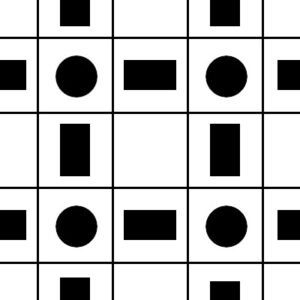A Monster’s Expedition: Double Parity
I’m getting into the tougher parts of A Monster’s Expedition, and I’m noticing patterns. Islands are grouped into clusters, separated by long raft rides, each with its own distinct skin for the terrain and trees. And they function on the DROD model. That is, there don’t seem to be any new gameplay elements introduced after you start encountering double-length trees fairly early on, but each island cluster focuses on a particular interaction. You’ll have a group of puzzles where you need to position a log where it’ll stop another log from rolling too far, a group of puzzles where you have to push a log into the water in a place where it doesn’t make a complete bridge so you can climb onto it and push another log from an otherwise inaccessible direction, and so forth. Recognizing these themes can be a great help. Sometimes when I return to an incompletely-solved cluster, I re-solve some of the easier puzzles to remind myself what I should be looking for in the harder ones.
Another useful pattern: parity. When you push a single-length log lengthwise, it doesn’t shift, but rather, tumbles. If it’s positioned east-west, and you push it from the west side, it’ll pivot up and come to rest upright, one tile east of where it was. Once it’s upright, you can choose to push it down from the north or south, changing its direction. This scheme has the consequence that if you never roll a log from the side — and you frequently can’t roll logs without losing them over the edge of the island — then its possible positions and orientations are bound by parity in two directions. In any 2×2 square, you’ll have one tile where it can only be upright, one where it can only be east-west, one where it can only be north-south, and one where it can never be at all. Rolling the log, making it move until it hits an obstacle such as a rock or another log, can break this: if it rolls an odd number of spaces, its parity will be changed in the direction it rolled.
 Trees always start off upright, so I find it useful to think of the grid of the world in terms of places where a particular tree can be upright without rolling. This is a pattern you can just perceive, if you try. If you know where a log needs to go, and what orientation it needs to have there, then you can scan to see if it has the right parities, and if not, what obstacles could change that. It takes a good long time to reach the point in the game where it’s at all useful to think in these terms, though. Mostly you can just assume rocks are useful because they’re there.
Trees always start off upright, so I find it useful to think of the grid of the world in terms of places where a particular tree can be upright without rolling. This is a pattern you can just perceive, if you try. If you know where a log needs to go, and what orientation it needs to have there, then you can scan to see if it has the right parities, and if not, what obstacles could change that. It takes a good long time to reach the point in the game where it’s at all useful to think in these terms, though. Mostly you can just assume rocks are useful because they’re there.
 Comments(1)
Comments(1)
Stephen’s Sausage Roll has a vaguely similar and yet different parity effect. Sausages roll over when you push them laterally but not when you push them widthwise, which means that a surface of a given sausage can only touch the ground on every other row that runs parallel to it, which constrains how you can grill it–until you get ways of breaking the parity. So there are two criss-crossing parities but they apply to different sausages facing different directions. Monster’s Expedition doesn’t have this because it doesn’t matter which side of the log is up.
This is also reminding me that the game that got me into Flash games, and thus eventually indie games, was a game called Blox (I think) where you played as a 2×1 block. From a lying-down position you could roll widthwise one block or stand up on one of the squares that was adjacent lengthwise. In general this doesn’t create parity issues but it often found a way to prevent you from rolling so you could only ostensibly stand up on every third square, and the trick was to find a way to roll over. Since there were nine possible subgrids there were a lot of ways to mess with this (so you might be able to easily get between two of the three positions on the y-axis but it was hard to get to the third). I can’t find it now but it seems to have been ported to/ripped off on phones.